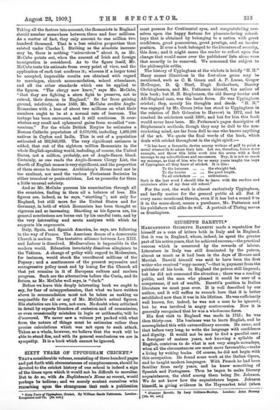SIXTY YEARS OF UPPINGHAM CRIbitteT. 11 THAT a considerable volume, consisting
of three hundred pages and put forth -with circumstances of sumptuousness, should be devoted to the cricket history of one school is indeed a sign of the times upon which it would not be difficult to moralise. But to do so, with An Englishman's Hams so recent, would perhaps be tedious ; and we merely content ourselves with remarking wen the strangeness that sash a publication
• Sixty Years Upyisykom Cricket, By William Seeds Patterson. London: Longnians and Co. L6s. neta
must possess for Continental eyes, and congratulating our- selves upon the happy fortune for pleasure-loving school- boys that is obtained by belonging to a nation with great confidence, great possessions, great prestige, and an insular position. If ever a book belonged to the literature of security, this does ; and it might cause the reader to reflect upon the change that would come over the publishers' lists alone were that security to be removed. We commend the subject to the philosophic critic.
The history of Uppingliam at the wickets is briefly "H. H." Many names illustrious in the first-class game may be mentioned, such as C. E. Green and A.. P. Lucas, Gregor McGregor, D. Q. Steel, Hugh Rotherham, Stanley Christopherson, and Mr. Patterson himself, the author of this book ; but H. H. Stephenson, the old Surrey bowler and All-England man, was the basic force. He was Uppingham cricket; they, merely his thoughts and deeds. "H. H." was engaged by Mr. Green (who has stood to Uppingliam in the relation of Bob Grimston to Harrow) in 1872, and he coached its cricketers until 1896; and but for him this book would never have been. Mr. Patterson's pages descriptive of Stephenson's methods, though they may be dull to the non- cricketing mind, are far from dull to one who knows anything of the art. We quote the final words of the book, which deals with cricket throughout in the right spirit "It has been a favourite device among writers of golf to point a moral wherewith to adorn their tale. Let me, therefore, follow their example, and throw this little work into the arena with a final message to my schoolfellows and successors. Nay, it is not so much my message, as that of him who for so many years taught the boys of Uppingham all they knew of cricket. It is this:
To the batsman the straight bat.
To the bowler ... the good length.
To all cricketers ... enthnsiasm.
Such is the last word I should like to leave with the readers and cricketers alike of my dear old school."
For the rest, the work is almost exclusively Uppingham, and hardly matter for the general public at all. But if every name mentioned therein, even if it has but a round 0 to it in the score-sheet, means a purchaser, Mr. Patterson and his publishers will alike do well. A portrait of Thring serves as frontispiece.






































 Previous page
Previous page